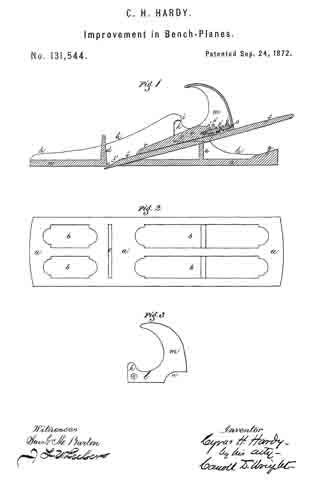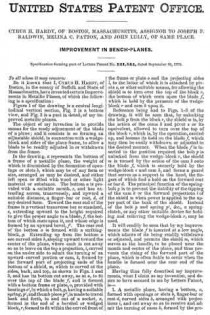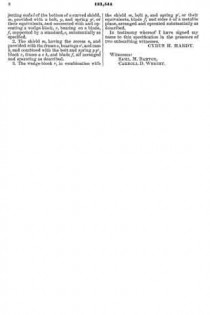
| PLEASE NOTE: The images presented on this page are of low resolution and, as a result, will not print out very well. If you wish to have higher resolution files then you may purchase them for only $2.95 per patent by using the "Buy Now" button below. All purchases are via PayPal. These files have all been cleaned up and digitally enhanced and are therefore suitable for printing, publication or framing. Each zip package contains all the images below (some packages may contain more), and purchased files can be downloaded immediately. |
UNITED STATES PATENT OFFICE.
_________________
CYRUS H. HARDY, OF BOSTON, MASSACHUSETTS, ASSIGNOR TO JOSEPH F.
BALDWIN, MELINA C. PATTON, AND JOHN LULLY, OF SAME PLACE.
IMPROVEMENT IN BENCH-PLANES.
_________________
Specification forming part of Letters Patent No. 131,544, dated September 24, 1872.
_________________
To all whom it may concern:
Be it known that I, CYRUS H. HARDY, of Boston, in the county of Suffolk and State of Massachusetts, have invented certain Improvements in Metallic Planes, of which the following is a specification:
Figure 1 of the drawing is a central longitudinal vertical section, Fig. 2 is a bottom view, and Fig. 3 is a part in detail, of my improved metallic planes.
The object of my invention is to provide means for the ready adjustment of the blade of a plane; and it consists in so forming an adjustable shield, in connection with a wedge-block and sides of the plane-frame, to allow a blade to be readily adjusted in or withdrawn from the frame.
In the drawing, a represents the bottom of a frame of a metallic plane, the weight of which is diminished by the formation of openings or slots b, which may be of any form or size, arranged as may be desired, and either left open or filled with wood or other light material or substance. The bottom a is provided with a suitable mouth, c, and has extending across, transversely, and upward a suitable distance, a finger-bar or rest, d, of any desired form. Toward the rear end of the frame is a vertical transverse bar or standard, e, extending upward to the height required to give the proper angle to a blade, f, the bottom of which rests upon it, and whose edge is formed by an upward bevel, f’. The rear end of the bottom a, is formed with a striking-block, g. Extending up from the bottom a are curved sides h, sloping upward toward the center of the plane, where each is cut away so as to leave on the top a projection, i, curved on the under side to admit the turning of an upward-curved portion or cam, k, formed by the forward part of projecting ends of the bottom of a shield, m, which is curved at the sides, back, and top, as shown in Figs. 1 and 3, and has its bottom cut away, as at n, to fit over the top of the blade f and is formed with a bottom frame or plate, o, provided with bearings o’, in which a bolt, p, having a suitable spring, p’, and thumb piece p” , is made to travel back and forth, in and out of a socket, x, formed in the end of a beveled or wedged block, r, formed to it within the curved front of the frame or plate o and the projecting sides l, to the latter of which it is attached by pivots s, or other suitable means, for allowing the shield on to turn over the top of the block r, the bottom of which rests upon the blade f, which is held by the pressure of the wedge-block r and cam k upon it.
Reference being had to Figs. 1-3 of the drawing, it will be seen that, by unlocking the bolt p from the block r, the shield m is, by the action of the cams k and pivot s or its equivalent, allowed to turn over the top of the block r, which is, by the operation, carried up, and lessens its hold on the blade f, which may then be easily withdrawn or adjusted in the desired manner. When the blade f is inserted in the position required the bolt p is unlocked from the wedge-block r, the shield m is turned by the action of the cam k onto the blade f which is securely held by the wedge-block r and cam k, and forms a guard that serves as a support to the hand, the fingers of which find a hold on the forward rest or bar d. The principal function of the spring-bolt p is to prevent the liability of the tipping of the cam is or the forward projections l of the shield m when power is applied to the upper part of the back of the shield. Instead of the bolt p and spring p’, &c., a spring-clutch, or any other suitable device for holding and relieving the wedge-block r, may be used.
It will readily be seen that by my improvements the blade f is inserted at a low angle, which admits of its being readily withdrawn or adjusted, and permits the shield m, which serves as the handle, to be placed near the mouth and center of the plane, and thus prevents the rising of the forward part of the plane, which is often liable to occur when the handle is formed near the rear end of the plane.
Having thus fully described my improvements, what I claim as my invention, and desire to have secured to me by Letters Patent, is —
1. A metallic plane, having a bottom, a, formed with openings or slots b, finger-bar or rest d, curved sides h, arranged with projections i, and cut away so as to receive and admit the turning of cams k, formed by the projecting ends l of the bottom of a curved shield, m, provided with a bolt, p, and spring p’, or their equivalents, and connected with and operating a wedge-block, r, bearing on a blade, f supported by a standard, e, substantially as specified.
2. The shield m, having the recess n, and provided with the frame o, bearings o’, and cam k, and combined with the bolt and spring p p’, block r, frame a e h, and blade f all arranged and operating as described.
3. The wedge-block r, in combination with the shield m, bolt p, and spring p’, or their equivalents, blade f and sides in of a metallic plane, arranged and operated substantially as described.
In testimony whereof I have signed my name to this specification in the presence of two subscribing witnesses.
CYRUS H. HARDY.
Witnesses :
SAML. M. BARTON,
CARROLL D. WRIGHT.



